When I started conducting walking tours at the Pima Air & Space Museum a few months ago, I quickly realized I’d talk myself hoarse if I didn’t overcome a certain egotistical reluctance to use a portable voice amplifier and speaker. The museum had two but they were big heavy things, each one powered by eight D-cell batteries. I went on Amazon and found a small, rechargeable, lightweight amplifier specifically designed for museum docents and tour guides. I bought one and started using it. Other docents noticed and asked about it, as did the head of the education department, a paid member of the museum staff. When I arrived to start my tours this morning, I discovered the museum had purchased four amps for docents to share.
Little old trend-setter me. But that’s not the reason I bring this up. It is to note that amp or no amp, I still come home raw-throated and hoarse after my weekly morning at the museum. I tell myself it’d be much worse without the amp, but I’m not totally convinced. Too bad I can’t write my way through a morning of tours!
It was cold inside the hangars today, but I was able work a newly-learned factoid into my presentation and that warmed me up a little. I knew that the Boeing B-29 bomber was developed in response to a late-1930s Army requirement for a “hemisphere defense weapon,” what we today would call a strategic bomber. What I didn’t know was that FDR’s war planners had anticipated the possibility that England might fall to the Germans, and that we might have to fight the Nazis from our home in America … hence the need for an intercontinental bomber.
As it turned out, of course, England did not fall, and we were able to base older B-17 and B-24 bombers in Britain to use against Germany. When the B-29 became operational we elected to use it in the Pacific, where its longer range enabled us to bomb targets in Japan.
I don’t have a Pearl Harbor story to share with you today, this 70th anniversary of the infamous attack, but I do have a tale from the other end of the war, September 2 1945, when we sailed the USS Missouri into Tokyo Bay and “invited” the Japanese aboard to sign the articles of surrender.
At the conclusion of the surrender ceremony on the USS Missouri, a massive flyover by Navy and Army Air Forces aircraft began … there were hundreds of carrier-based fighters and torpedo bombers, and hundreds of long-range land-based B-29 bombers. The flyover was part celebration, part showing off … and part show of force. The emperor had only surrendered two weeks previously, and we didn’t yet have American forces on the ground in Japan. We didn’t know just how much the Japanese military and civilian population had bought into the emperor’s surrender proclamation.
I don’t know about the Navy aircraft, but the crews of every AAF B-29 that flew in the surrender flyover were allowed to stencil the Morse Code for the letter V (three dots and a dash) on their aircraft, right there with the stencils signifying combat bombing missions. Our B-29 was there, and if you click on the photo above to enlarge it, you’ll see the V for Victory symbol just below the cockpit windows.
Now there’s a hemisphere defense weapon for you!
